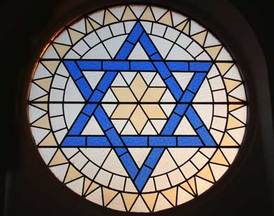
A Jewish holiday or festival is a day or series of days observed by Jews as a holy or secular commemoration of an important event in Jewish history. In Hebrew, Jewish holidays and festivals, depending on their nature, may be called yom tov (good day) or chag (festival) or ta'anit (fast).
Rosh Hashanah — The Jewish New Year - According to the Talmud and oral tradition, Rosh Hashanah is the Jewish new year, day of memorial and the day of judgment, in which God judges each person individually according to their deeds, and makes a decree for the following year. The holiday is characterized by the special mitzvah of blowing the shofar. According to the Torah, however, this is the first day of the seventh month of the calendar year that marks the beginning of a ten day count to Yom Kippur.
Aseret Yemei Teshuva — Ten Days of Repentance - The first ten days of the seventh month of the Jewish year (from the beginning of Rosh Hashana until the end of Yom Kippur) are known as the Aseret Yemei Teshuva. During this time it is "exceedingly appropriate" for Jews to practice "Teshuvah," which is examining one's deeds and repenting for sins committed against both God and one's fellow man in anticipation of Yom Kippur. This repentance can take the form of additional supplications, confessing one's deeds before God, fasting, and self-reflection. On the third day, the Fast of Gedalia is celebrated.
Yom Kippur — Day of Atonement - Yom Kippur is considered by Jews to be the holiest and most solemn day of the year. Its central theme is atonement and reconciliation. Eating, drinking, bathing, anointing with oil, and marital relations are forbidden. Fasting begins at sundown, and ends after nightfall the following day. Yom Kippur services begin with the prayer known as "Kol Nidrei", which must be recited before sunset.
Hanukkah — Festival of Lights - Hanukkah marks the defeat of Seleucid Empire forces that had tried to prevent the people of Israel from practicing Judaism. Judah Maccabee and his brothers destroyed overwhelming forces, and rededicated the Temple in Jerusalem. The eight-day festival is marked by the kindling of lights — one on the first night, two on the second, and so on — using a special candle holder called a Chanukkiyah, or a Hanukkah menorah.
Pesach — Passover
Erev Pesach and Fast of the Firstborn known as "Ta'anit Bechorim" — 14 Nisan
Passover 15 and 16 Nisan
The "Last days of Passover", known as Acharon shel Pesach, are also a holiday commemorating K'riat Yam Suf, the Passage of the Red Sea. — 21 and 22 Nisan
The semi-holiday days between the "first days" and the "last days" of Passover are known as Chol Hamo'ed, referred to as the "Intermediate days".
Passover commemorates the liberation of the Israelite slaves from Egypt. No leavened food is eaten during the week of Pesach, in commemoration of the fact that the Jews left Egypt so quickly that their bread did not have enough time to rise.
Rosh Chodesh — the New Month - The first day of each month and the thirtieth day of the preceding month, if it has thirty days, a minor holiday known as Rosh Chodesh (head of the month). The one exception is the month of Tishrei, whose beginning is a major holiday, Rosh Hashanah. There are also special prayers said upon observing the new Moon for the first time each month.
Shabbat — The Sabbath - Jewish law accords Shabbat the status of a holiday, a day of rest celebrated on the seventh day of each week. Jewish law defines a day as ending at nightfall, which is when the next day then begins. Thus, Shabbat begins at sundown Friday night, and ends at nightfall Saturday night.
New Israeli/Jewish national holidays
-Yom Yerushalayim — Jerusalem day
-Yom HaShoah — Holocaust Remembrance day
-Yom Hazikaron — Memorial Day
-Yom Ha'atzmaut — Israel Independence Day
-These four days are national holidays in the State of Israel, and in general have been accepted as religious holidays by the following groups: The Union of Orthodox Congregations and Rabbinical Council of America; The United Hebrew Congregations of the Commonwealth (United Kingdom); The Chief Rabbinate of the State of Israel; All of Reform Judaism and Conservative Judaism; The Union for Traditional Judaism and the Reconstructionist movement.
-Yom Ha'atzmaut — Israel Independence Day
-Yom Ha'atzmaut is Israel's Independence Day. An official ceremony is held annually on the eve of Yom Ha'atzmaut at Mount Herzl. The ceremony includes speeches by senior Israeli officials, an artistic presentation, a ritual march of flag-carrying soldiers forming elaborate structures and the lighting of twelve beacons. Dozens of Israeli citizens, who contributed significantly to the state, are selected to light these beacons.














